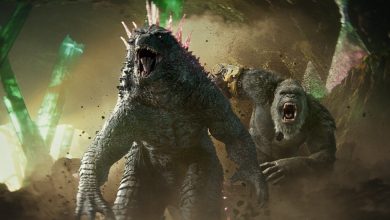‘Inu-oh’ Review: Dazzling Anime Meets Medieval Epic

Visually sumptuous and narratively tangled, the anime “Inu-oh” takes place in 14th-century Japan. The main story does, at least. It tells of two young, audaciously talented castaways — a blind musician and a cursed dancer — who meet one dark evening. After the usual how-do-you-do, they begin performing for each other and quickly slide into enchanted sync. Together, they frolic and jam and whirl, and before long they’re levitating, gyrating against an expanse of shimmery stars as they orbit each other like heavenly bodies.
It’s fitting that these characters meet on a bridge, given that the movie spans past and present, reality and fantasy. It’s based on a novel, “The Tale of the Heike: The Inu-oh Chapters,” by the Japanese writer Hideo Furukawa that riffs on “The Tale of the Heike,” a foundational medieval epic about clans engaged in civil war. A font of innumerable interpretations, the original tale reaches a climax with the battle of Dan-no-Ura, during which the Heike clan is defeated, the child emperor drowned and a sacred imperial sword lost. That sword pops up periodically in “Inu-oh” — but good luck understanding why.
What the sword — which at times drips blood — has to do with our two whirling strangers isn’t altogether clear. Those who’ve read Furukawa’s novel, which doesn’t seem to have been translated into English, may have no issue tracking the movie’s labyrinthine turns, its time shifts, storytelling elisions and fantastical flourishes. After the first hour or so and having forgotten much of the (confusing!) introductory exposition, I gave up trying to fit the pieces together. Instead, I just grooved along on the often-spectacular animation, savoring its watery hues, vivid character designs and recurrent, galvanizing embrace of near-abstraction.
The director Masaaki Yuasa (“Ride Your Wave”) opens “Inu-oh” with a great whoosh of images that announce his visual ambitions and give you little time to establish your bearings. After a short, vivid sprint across time, the story settles on Tomona (voiced by Mirai Moriyama), a boy who lives in a fishing village with his parents. One day, two royal emissaries commission Tomona’s father to dive for a mysterious treasure. It goes disastrously wrong; the father is killed and Tomona blinded. He leaves home but soon finds a calling, becoming a biwa (lute) player and eventually meeting the stranger on the bridge.
That would be Inu-oh (Avu-chan, from the rock band Queen Bee), and his background adds complications. A pariah born with severe deformities, including an arm that’s longer than his coltish legs — when he runs, it trails him as perilously as Isadora Duncan’s scarf — Inu-oh hides his face under a gourd mask. He also speaks with an adenoidal whine and scrambles about with feverish agility that evolves into a kind of superpower after he and Tomona meet. Together, they hit the road and refine their talents: Inu-oh becomes a performing sensation and Tomona a proto-rocker, complete with squealing biwa and admirers.
Given the attention Yuasa lavishes on these passages, it’s clear that he loves the idea of 14th-century performers rocking out like modern-day arena gods. If nothing else, these interludes have a storytelling clarity and directness that’s otherwise lacking here. (The script is by Akiko Nogi.) Certainly it’s amusing to watch Tomona jam: He plays his biwa behind his head à la Jimi Hendrix (to be clear, the resemblance is strictly gestural), whips around his luxurious mane and bares his chest, lathering up the crowd. Yet while in time the performances reveal truths about the players and their lives, they rapidly grow tiresome.
Still, sometimes beauty is enough (or almost). And “Inu-oh” is often visually arresting, starting with an early interlude that, with its washes of color, delicate figures, negative space and lateral movements, looks like an animated scroll painting. This sequence, like the rest of the movie, retains a strong trace of the human hand and shows a deep grasp of (and pleasure in) the medium’s plasticity, all of which are too often absent in contemporary commercial animation. Even as Yuasa’s approach changes from section to section — as he plays with texture, volume and hue and gently shifts the balance between the figurative and the abstract — his extraordinary touch remains evident in each line and in every eye-popping swirl.
Inu-oh
Rated PG-13 for mild peril and death. In Japanese, with subtitles. Running time: 1 hour 38 minutes. In theaters.



